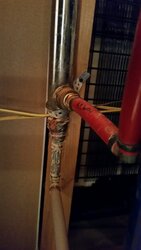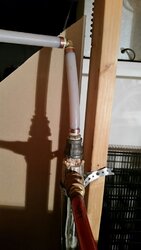I've got my DHW plumbed in to be heated with a side-arm heat exchanger. Originally I did not circulate the DHW side but found it ineffective so added a circulating pump on the DWH side (boiler side also circulates). I've experienced corrosion issues on the DHW side. Yes, I do have dissimilar metals in contact, mainly copper, brass, stainless steel and black steel as well as whatever I'm contacting at the DWH tank heater. I've researched the galvanic corrosion issue a bit although there seems to be a wide variety of opinion on the matter. It doesn't appear there is a direct commercial product available for the problem. Does anyone have any experience with similar corrosion issues? What about experience utilizing a sacrificial anode (e.g.corrosion grenade or similar)? I do believe I've lost an electric DHW heater to the problem...
Galvanic Corrosion Protection for DHW Side-Arm Heat Exchanger
- Thread starter timberbuilt
- Start date
-
Active since 1995, Hearth.com is THE place on the internet for free information and advice about wood stoves, pellet stoves and other energy saving equipment.
We strive to provide opinions, articles, discussions and history related to Hearth Products and in a more general sense, energy issues.
We promote the EFFICIENT, RESPONSIBLE, CLEAN and SAFE use of all fuels, whether renewable or fossil.



